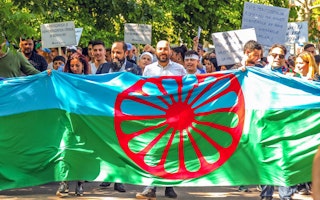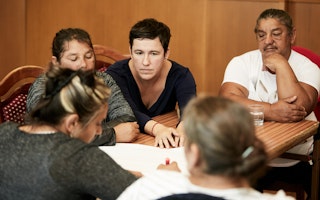Roma Killing in Kisleta: The Sixth Execution
By Szilvia Varró
The following article originally appeared in Magyar Narancs. Szilvia Varró is a fellow of the Open Society Institute Roma Initiatives.
Mária Balog is the sixth fatality in a series of assaults on Roma people that began in 2008. Following earlier attacks in Nagycsécs, Tatársztentgyörgy and Tiszalök, this time unidentified perpetrators committed a murder in Kisléta in Szabolcs County. By the following day, the police admitted that the incident was connected to the previous killings, and raised the reward for information to a record 100 million Hungarian forints.
“My mom is feeling dizzy in her room, my mom is feeling dizzy in her room”, 13-year-old Ketrin shouted to her aunt Gizella Balog as she approached the house. Gizella and her sister Aranka, on their way to harvest tobacco, stopped their car and honked the horn outside Mari’s house, but Mari never came out. The garden gate was undamaged, but the front door was smashed in, and the door-post bore the marks of shotgun blasts. Inside Gizella was met by the young girl, her tee-shirt and shorts heavily bloodstained. She had dried blood on her neck, her mouth was swollen, her face was pale and puffy; she was standing in a state of shock in a room to the right of the house. Gizella spotted five wounds on Ketrin’s arm. She asked her niece what happened. The little girl replied: “The door just slammed shut, this is why everything is covered with blood”.
The door between the small hallway and the larger room was open, a blanket on the floor; Mária was lying on the bed, there was an awful amount of blood all around her. The forty-five year-old woman lay on her right side, her left leg dangling and covered in blood, her hands in front of her body. According to the sisters’ account she had more wounds on her body than the little girl. “Mari, Mari, what's happened, are you dead?” Gizella cried out. By then Aranka had also entered the house. She touched Mária’s body, it was cold as ice. By then, she had been lying dead there for five hours. The little girl had spent all this time under the same roof with the corpse of her murdered mother.
The Last Street
Around 12 o'clock the neighbors heard several repeated bangs; there is no knowing why nobody came over to look around. Some were afraid; others thought that people were hunting in the neighborhood. One neighbor sent her husband out to investigate, but he saw nothing. The front door of Mari’s house was blasted by gunshot, as was the little girl’s room where the floor was covered with shards of window glass. It has not been established whether Mária was shot dead in her sleep, or whether she was hit in the hallway and managed to make it to her bed—the first version seems more likely, because blood stains could only be found at the bed.
Bocskai Street is the last street on the edge of the village; behind Maria’s house there are cornfields and beyond them lies the county border at Nyírbogát. Although the Roma people live in three different sections of Kisléta, segregated from the Hungarians, much like in a ghetto, there are no ‘Gypsy colonies’ in the classical sense of the word. The houses in Bocskai Street are poor but well-kept, there is no garbage scattered around, and although most have outside toilets, the homes are well-maintained. 35 percent of the 1,870 residents are Roma, and most of them engaged in seasonal work but work nonetheless just like the Balogh family. Mária’s mother gave birth to ten children, and now she has lost her second. The old woman is now afraid for her grandchild. “Close the door after mom”, Ketrin told her aunt as she was taken out on a stretcher. Her relatives went with her to the hospital in Nyíregyháza, where she underwent a six hour-long operation in the intensive care unit. For quite some time her condition was life-threatening; right now she is on the critical list. Dozens of lead shots were found on her head, upper body and left arm.
Roma in the locality noticed nothing suspicious in the days leading up to the attack: there were no sightings of black jeeps or unknown people in the vicinity of Bocskai Street. According to Mayor Sándor Pénzes, Roma and non-Roma people lived in peace in the village, the Balogh family was just one of the many diligent and hard-working families, and there was no usury in Kisléta. Mária’s husband died 12 years ago, and her elder daughter lived separately with her partner. Mária looked after Ketrin as a single mother. The little girl had just finished sixth grade in the local integrated school with good results.
When we visit the site, the detectives of the National Bureau of Investigation are swarming all over the place. The elderly mother and sisters are politely interrogated about one of Mária’s past relationships. According to Aranka, her sister had a brief affair a year ago, but it was already a thing of the past. Later we learn from a potentate from the village that there may be “jealousy” factor in the case; the ex-lover kept calling Mária from time to time. It is quite another matter whether a simple Roma man could have hundreds of thousands of forints to buy a shotgun. This version of the story is further weakened by the fact that the police, who have been searching for evidence and information since six in the morning, could easily check the alibi of a man living in the neighboring village. It is also true though that when investigating another murder committed against the Roma, it took several months for the police before they even began to check the phone calls of the relatives made on the night of the murder.
The Series
As early as Monday afternoon the police released an announcement that the case bore similarities to several other recent attacks on the Roma minority. On the basis of an immediate on-the-spot analysis conducted by Narancs, we can say the following: similar to previous attacks, Kisléta lies less than 15 minutes distance from the motorway - it can be easily accessed. Street-lighting is quite poor here also, and the street is right on the edge of the village, although the house is not the last one, as it was in Tatárszentgyörgy and Tiszalök. Again, it is a little girl who is the potential key witness: Ketrin might have seen the perpetrators just like Bianka in Tatárszentgyörgy, who was shot in the hand by the attackers.
There were no Molotov cocktails used here, as in a dozen other cases. Neither were there any sightings of a black jeep. Just like Jenő Kóka shot dead by a sniper in Tiszalök, the victim was a Roma person on her way to work.
However, the key difference here is that this is the first time that the perpetrators broke into and entered the house to kill their victim (before the attackers either opened fire from nearby or ambushed their victims as they left the house). The attacks usually took place around midnight, often Sunday night Monday morning. As in this case, there is often a meadow, a forest or fields next to the targeted houses, allowing for a quick escape. Prior to the Kisléta attack, the police had already established a connection between seven other cases based on the weapon used. The perpetrators might be well-to-do people; at least that's what their jeeps and expensive weapons suggest. In connection with the previous cases the police have said that there may be policemen, soldiers or members of some other armed forces among the perpetrators. Because they can shoot remarkably straight, move swiftly across ground, and execute well-planned military-style maneuvers. The killers usually encircle their victims and shoot from several different angles.
The Victims
On 22 July three houses in Galgagyörk were hit by gunfire. In Piricse a Molotov cocktail was thrown at two homes in which children were sleeping. Lead shots hit the house, and an old woman was injured. Last September a house was shot at in Nyíradony-Tamásipuszta in which both parents and children were sleeping. In December a young Roma man, was hit by shotgun blast as he attempted to steal some woodwho wanted to steal some wood in Alsózsolca. The case in Nagycsécs claimed two lives, a father and his son died in Tatárszentgyörgy, and most recently a man in Tiszalök was killed too. The surviving family members have not received any assistance from the state to cope with the trauma. The Roma organized to protect themselves most intensively in Tatárszentgyörgy, but a few months later they had to stop patrolling because they couldn't pay for it.
Szilvia Varró was an Open Society Roma Initiatives Fellow.


